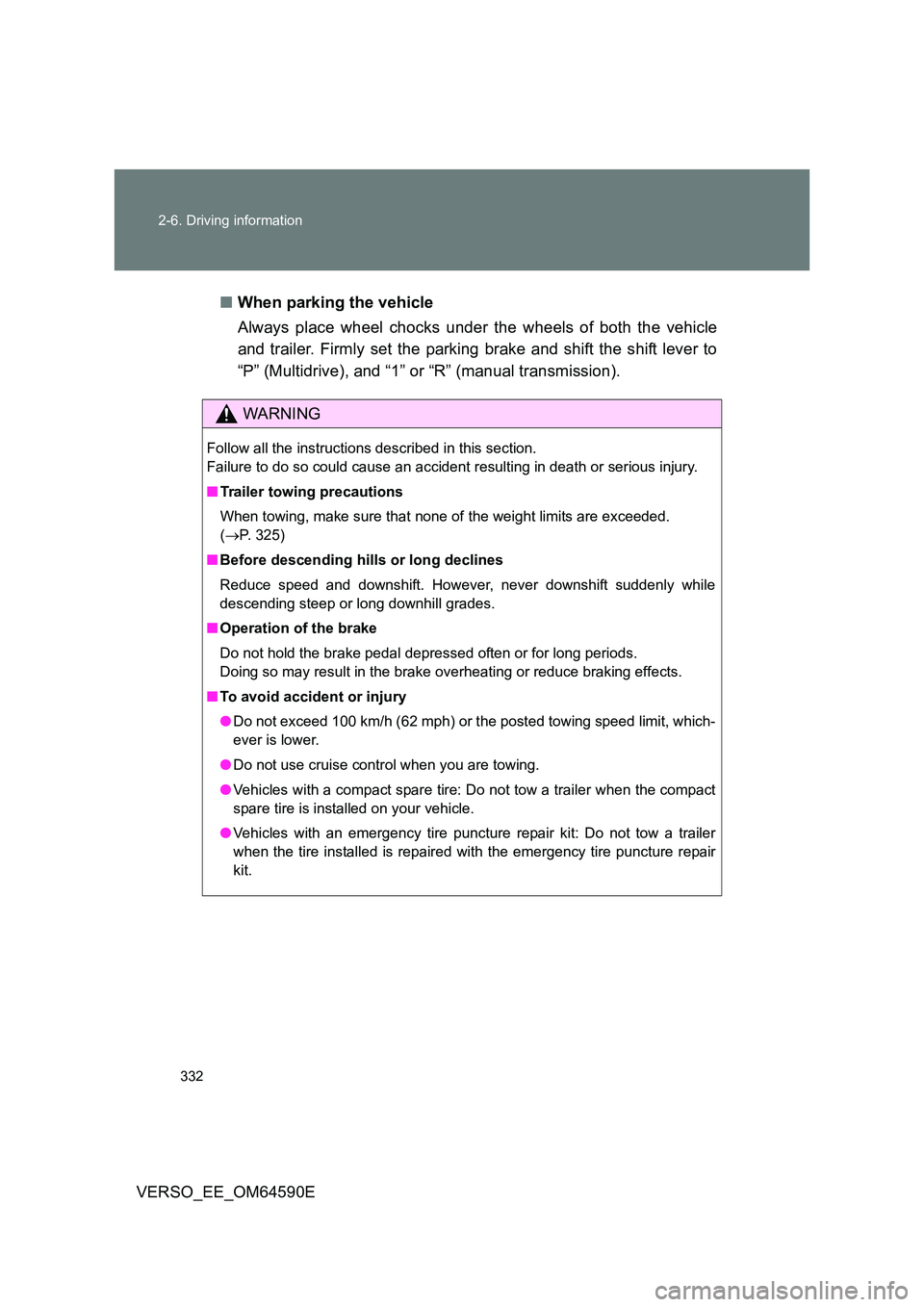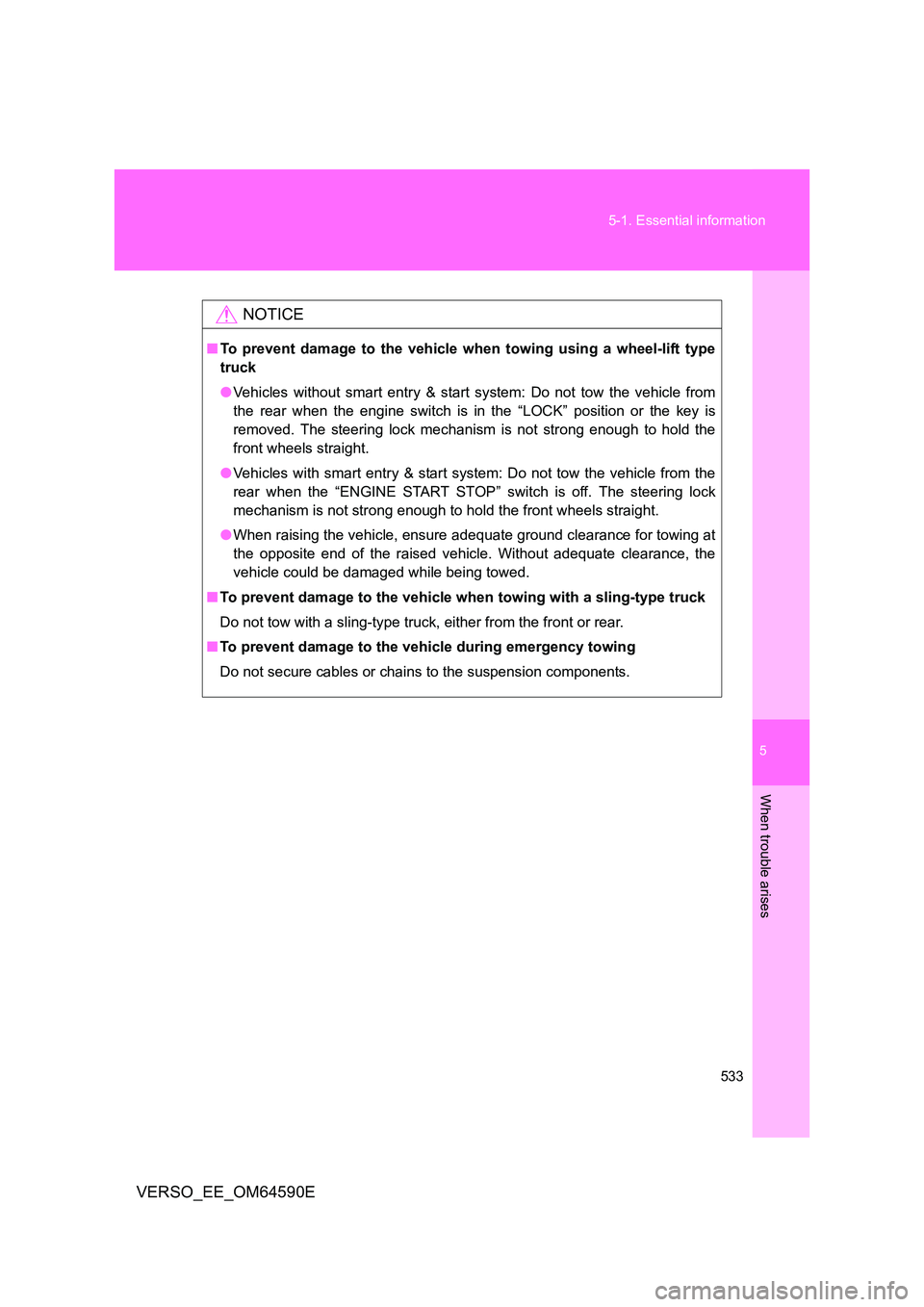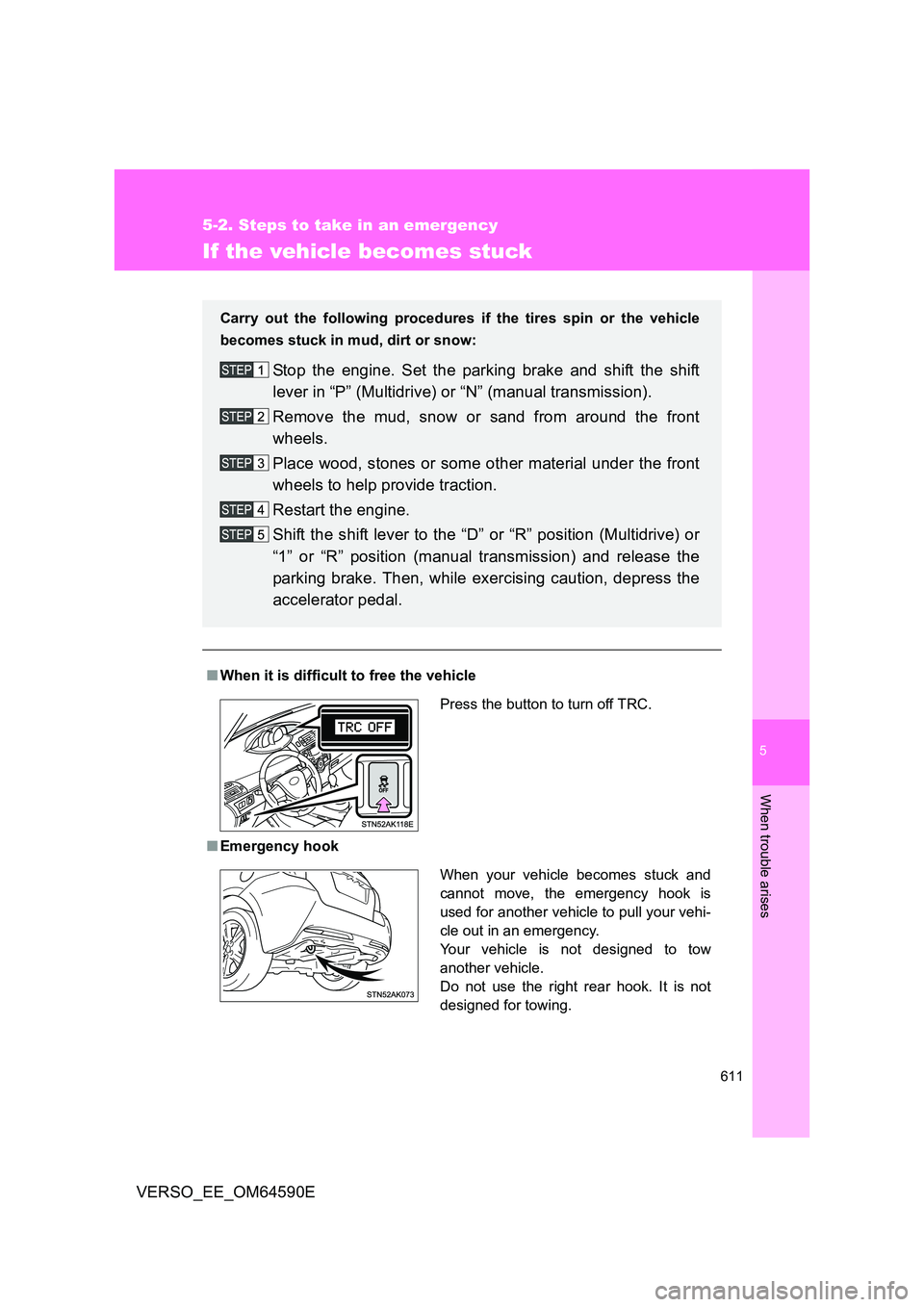Page 332 of 664

332
2-6. Driving information
VERSO_EE_OM64590E
■ When parking the vehicle
Always place wheel chocks under the wheels of both the vehicle
and trailer. Firmly set the parking brake and shift the shift lever to
“P” (Multidrive), and “1” or “R” (manual transmission).
WARNING
Follow all the instructions described in this section.
Failure to do so could cause an accident resulting in death or serious injury.
■ Trailer towing precautions
When towing, make sure that none of the weight limits are exceeded.
( P. 325)
■ Before descending hills or long declines
Reduce speed and downshift. However, never downshift suddenly while
descending steep or long downhill grades.
■ Operation of the brake
Do not hold the brake pedal depressed often or for long periods.
Doing so may result in the brake overheating or reduce braking effects.
■ To avoid accident or injury
● Do not exceed 100 km/h (62 mph) or the posted towing speed limit, which-
ever is lower.
● Do not use cruise control when you are towing.
● Vehicles with a compact spare tire: Do not tow a trailer when the compact
spare tire is installed on your vehicle.
● Vehicles with an emergency tire puncture repair kit: Do not tow a trailer
when the tire installed is repaired with the emergency tire puncture repair
kit.
Page 529 of 664
5
529
5-1. Essential information
When trouble arises
VERSO_EE_OM64590E
Using a flatbed truck
If your vehicle is transported by a
flatbed truck, it should be tied
down at the locations shown in
the illustration.
If you use chains or cables to tie
down your vehicle, the angles
shaded in black must be 45
Do not overly tighten the tie
downs or the vehicle may be
damaged.
Emergency towing
If a tow truck is not available in an emergency, your vehicle may be
temporarily towed using cables or chains secured to the emergency
towing eyelets. This should only be attempted on hard surfaced roads
for at most 80 km (50 miles) at under 30 km/h (18 mph).
A driver must be in the vehicle to steer and operate the brakes. The
vehicle’s wheels, drivetrain, axles, steering and brakes must be in
good condition.
Front
Page 530 of 664
530
5-1. Essential information
VERSO_EE_OM64590E
Emergency towing procedure
Take out the towing eyelet. ( P. 560, 578)
Remove the eyelet cover using a
flathead screwdriver.
To protect the bodywork, place a
rag between the screwdriver and
the vehicle body, as shown in the
illustration.
Insert the towing eyelet into the
hole and tighten partially by
hand.
Tighten down the towing eyelet
securely using a wheel nut
wrench or hard metal bar.
Page 533 of 664

5
533
5-1. Essential information
When trouble arises
VERSO_EE_OM64590E
NOTICE
■ To prevent damage to the vehicle when towing using a wheel-lift type
truck
● Vehicles without smart entry & start system: Do not tow the vehicle from
the rear when the engine switch is in the “LOCK” position or the key is
removed. The steering lock mechanism is not strong enough to hold the
front wheels straight.
● Vehicles with smart entry & start system: Do not tow the vehicle from the
rear when the “ENGINE START STOP” switch is off. The steering lock
mechanism is not strong enough to hold the front wheels straight.
● When raising the vehicle, ensure adequate ground clearance for towing at
the opposite end of the raised vehicle. Without adequate clearance, the
vehicle could be damaged while being towed.
■ To prevent damage to the vehicle when towing with a sling-type truck
Do not tow with a sling-type truck, either from the front or rear.
■ To prevent damage to the vehicle during emergency towing
Do not secure cables or chains to the suspension components.
Page 560 of 664
560
5-2. Steps to take in an emergency
VERSO_EE_OM64590E
If you have a flat tire (vehicles with spare tire)
Your vehicle is equipped with a spare tire. The flat tire can be
replaced with the spare tire.
■ Before jacking up the vehicle
● Stop the vehicle on a hard, flat surface.
● Set the parking brake.
● Shift the shift lever to “P” (Multidrive) or “R” (manual transmis-
sion).
● Stop the engine.
● Turn on the emergency flashers. (P. 526)
■ Location of the spare tire, jack and tools
Vehicles without the third seat
Spare tire
Jack handleJack
Wheel nut wrench
Towing eyelet
Page 561 of 664
5
561
5-2. Steps to take in an emergency
When trouble arises
VERSO_EE_OM64590E
Vehicles with third seats
Spare tire
Jack handle
Jack
Wheel nut wrench
Towing eyelet
Page 578 of 664
578
5-2. Steps to take in an emergency
VERSO_EE_OM64590E
■ Location of the emergency tire puncture repair kit
Vehicles without the third seats
Vehicles with the third seats
Emergency tire puncture repair kit*3
Towing eyelet
Jack*1Wheel cap clip*2
Wheel nut wrench*1
Jackhandle*1
Emergency tire puncture repair kit*3
Towing eyelet
Wheel nut wrench*1
Jack handle*1
Wheel cap clip*2
Jack*1
Page 611 of 664

5
611
5-2. Steps to take in an emergency
When trouble arises
VERSO_EE_OM64590E
If the vehicle becomes stuck
■When it is difficult to free the vehicle
■ Emergency hook
Carry out the following procedures if the tires spin or the vehicle
becomes stuck in mud, dirt or snow:
Stop the engine. Set the parking brake and shift the shift
lever in “P” (Multidrive) or “N” (manual transmission).
Remove the mud, snow or sand from around the front
wheels.
Place wood, stones or some other material under the front
wheels to help provide traction.
Restart the engine.
Shift the shift lever to the “D” or “R” position (Multidrive) or
“1” or “R” position (manual transmission) and release the
parking brake. Then, while exercising caution, depress the
accelerator pedal.
Press the button to turn off TRC.
When your vehicle becomes stuck and
cannot move, the emergency hook is
used for another vehicle to pull your vehi-
cle out in an emergency.
Your vehicle is not designed to tow
another vehicle.
Do not use the right rear hook. It is not
designed for towing.